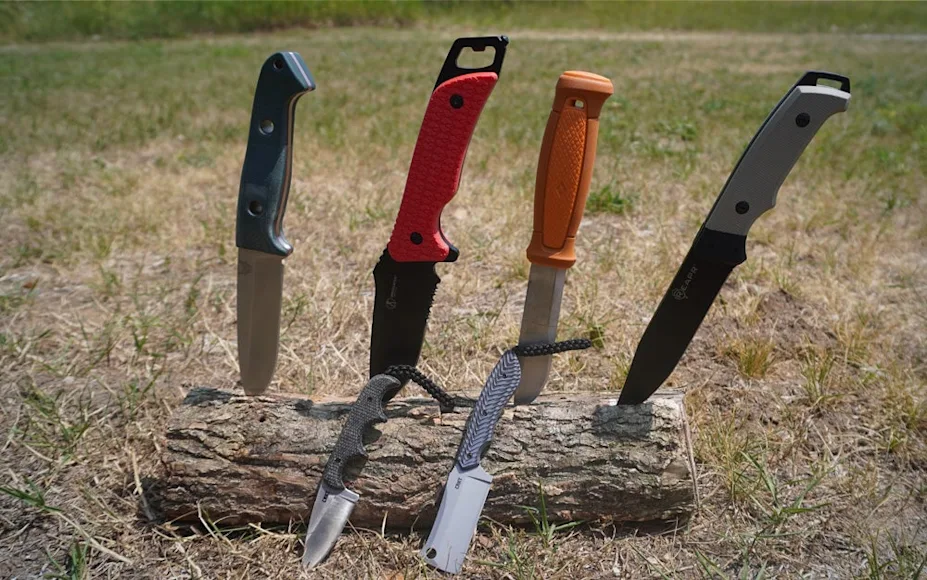_We may earn revenue from the products available on this page and participate in affiliate programs. Learn more ›
_
Backpacking knives are essential for survival in remote wilderness. They can help with anything from food preparation and tent repair to cleaning game and starting fires. But what distinguishes a backpacking knife? Like any other piece of gear you bring into the backcountry, your knife should be lightweight and low profile. This helps shed weight in your pack while remaining prepared for any situation mother nature throws at you.
Most modern camping and survival knives
are case-specific. Meaning your knife should be tailored toward an intended use in the field. But no matter the pursuit, all quality knives are made from lightweight, durable steel. It should also feature an ergonomic design that feels comfortable in hand. With this in mind, we did some in-the-field testing of multiple blades to find the best backpacking knives for a variety of uses and budgets.
The Best Backpacking Knives
Best Overall: Benchmade Bushcrafter
Best Fixed Blade: Morakniv Kansbol Fixed Blade
Best Budget: Reapr Brigade Fixed Blade
Best Grip: Uncharted Supply Co Empire Knife
Best Ultralight: CRKT Minimalist Drop Point
Best Chef Knife: CRKT S.P.E.C. Fixed Blade
Best Overall: Benchmade Bushcrafter
Specs
Blade Material: CPM-S30V Steel
Blade Length: 4.40”
Overall Length: 9.15”
Tang: Full
Pros
Beautiful looks
Ergonomic wide handle
Extremely sharp out of the box
Cons
No ferro rod included
Expensive
Benchmade continues to be the standard in the outdoor industry for bushcraft and camping knives
. The Bushcrafter is proof of that. This knife has a wider handle and a thicker blade than any of the other knives we tested. That wide handle gives this knife excellent feel and balance in hand. I wasn’t afraid to put some heavy pressure on the full tang for tougher jobs.

A close-up of the Benchmade Bushcrafter during testing. (Photo/Travis Smola)
The CPM-S30V steel has a sharp edge straight out of the box. It sliced through large pieces of cardboard like it was butter. I did eventually wear the edge down, but it took some time. Longer than the other blades in the test.
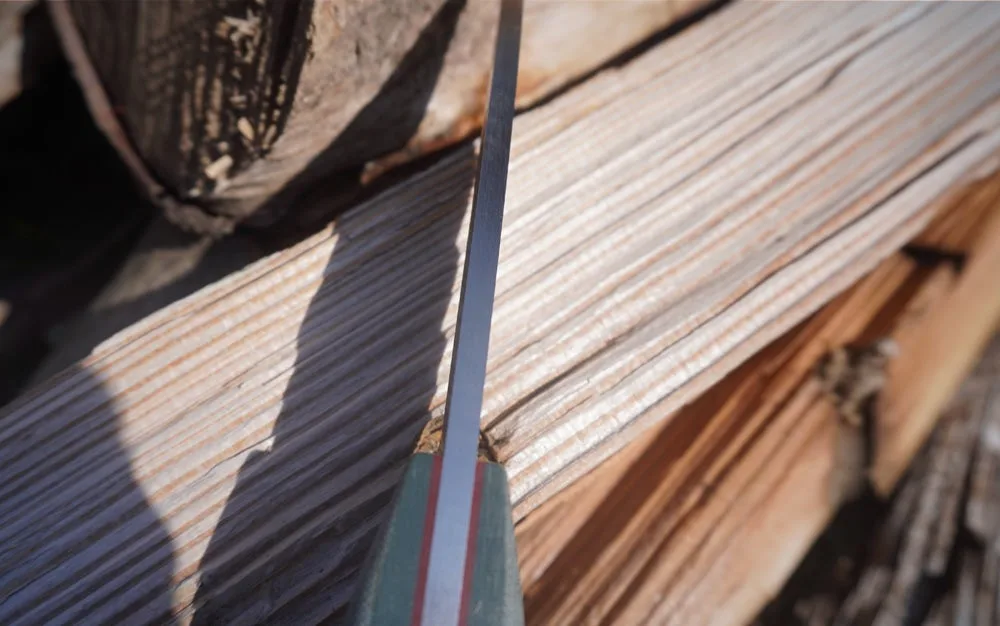
The Bushcrafter’s beefy blade will baton wood if called upon. (Photo/Travis Smola)
It’s a little puzzling Benchmade doesn’t include a ferro rod, especially since there’s a loop for it on the sheath. However, I tested it with a cheap rod and found the sharp spine does make a hell of a spark if called upon for that task. I also tried batoning wood with the Bushcrafter. I did this after the edge retention test, so the blade was starting to get dull. But that didn’t matter because of the beefy construction, which split the wood rather effortlessly without any visible damage to the blade. The Bushcrafter comes with a $300 price tag, but after the abuse I subjected it to, I think it’s worth every penny.
Best Fixed Blade: Morakniv Kansbol Fixed Blade
Specs
Blade Material: Swedish 12C27 Stainless
Blade Length: 4.29”
Overall Length: 9”
Tang: Partial
Pros
Affordable
Great fire starter
Incredibly lightweight
Cons
Not a full tang
Low-quality steel
While the Morakniv Kansbol doesn’t look special, it is a surprisingly capable fixed blade knife
, especially considering the sub $60 price tag. The blade is a bit thin, and the 12C27 steel is going to draw a lot of comparisons to other types of low-quality steel. But I don’t think that’s necessarily a downside.
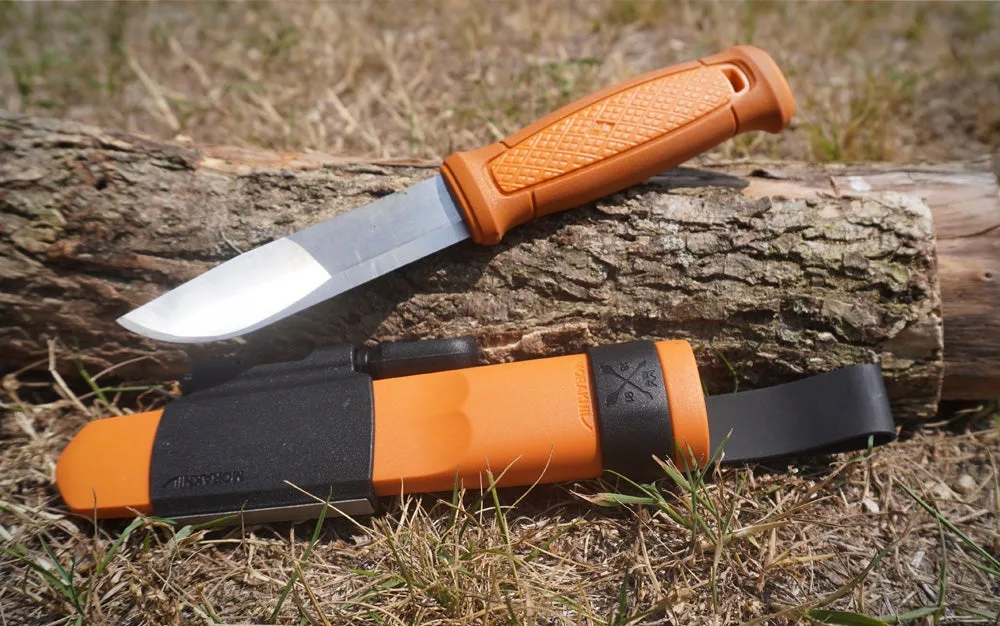
A close-up of the Morakniv Kansbol during testing. (Photo/Travis Smola) Travis Smola
This is a knife I haven’t been afraid to abuse because it is so cheap. While it doesn’t have a full tang, it does feel surprisingly robust for a budget knife. I wouldn’t baton wood with it, but it can do just about every other bushcraft technique. The handle is also surprisingly comfortable, and I like the grip it provides for tougher jobs.
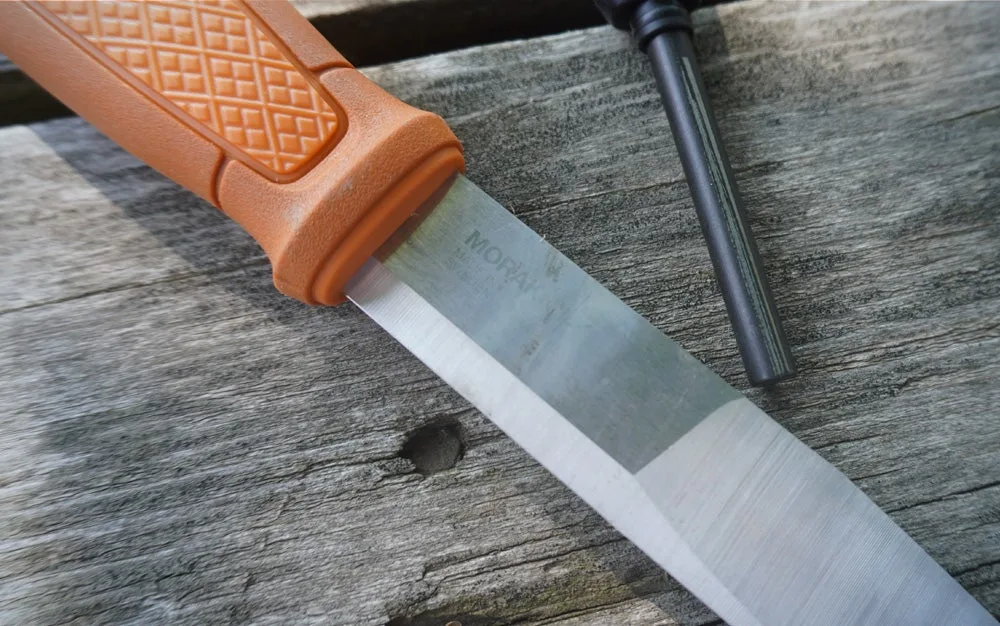
The Kansbol’s biggest strength is its fire-starting ability with the included ferro rod. (Photo/Travis Smola)
It’s worth getting the survival kit sheath bundle that includes a ferro rod, because, out of all the fire steel compatible blades I tested, the ground spine of this blade threw the biggest spark. If I need to start a fire quickly, I’d want the Kansbol in my pack. While it doesn’t offer much in the looks department, I can’t argue with the functionality and excellent edge retention. It is the perfect starter knife for someone just getting into backpacking.
Best Budget: Reapr Brigade Fixed Blade
Specs
Blade Material: 420 Stainless Steel
Blade Length: 5”
Overall Length: 10”
Tang: Full
Pros
Great price point
Good sharpness out of the package
Rigid enough for tougher bushcrafting jobs
Cons
The sheath could be better
Reapr is still a relatively new company, and I only became familiar with their knives in the last year. They sent me a few blades to test, but I like the simple and straightforward nature of the Brigade the most. It has a 5-inch drop point, and the 420 stainless steel blade came out of the package surprisingly sharp.
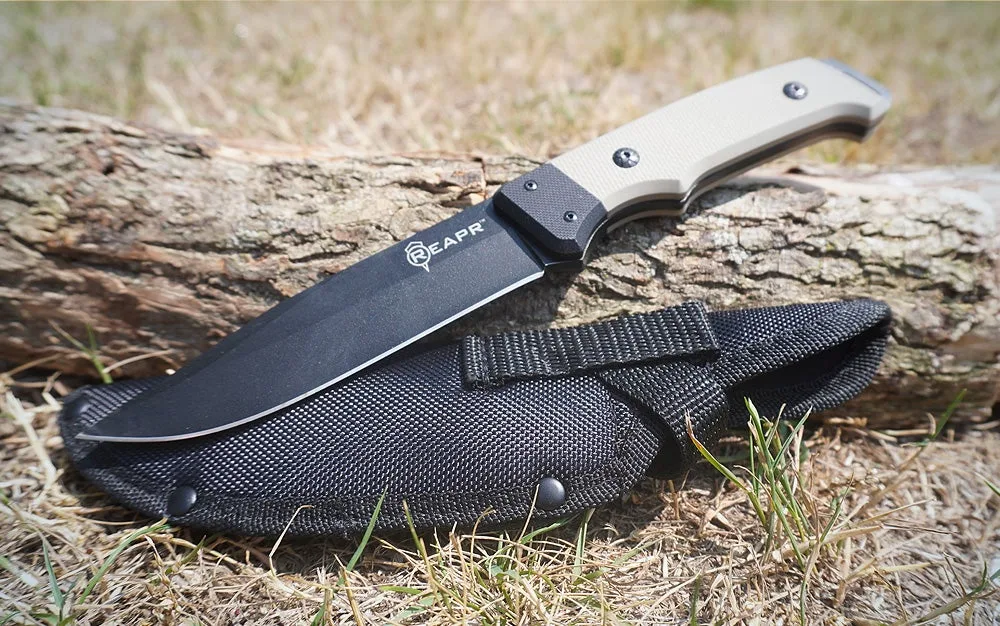
A close-up of the Reapr Brigade during testing. (Photo/Travis Smola) Travis Smola
The Brigade was the thinnest blade of all the full tang knives we tested. However, the scaling of the handle felt great for a $30 knife. And with a full tang, I quickly found it was robust enough for most bushcraft jobs.

The Brigade did show permanent signs of wear after the wood-splitting test, but the edge was still there. (Photo/Travis Smola) Travis Smola
While the Brigade does have a thinner blade, I still decided to subject it to a wood batoning test. And it was more than up for the task. There were some noticeable marks in the finish afterward, but that doesn’t bother me. This blade is a workhorse, not a showpiece. And because the price point is so low, it’s not a blade I’d worry about abusing or losing while deep in the backcountry. It also holds an edge surprisingly well for a budget knife.
Best Grip: Uncharted Supply Co Empire Knife
Specs
Blade Material: 420 Stainless Steel
Blade Length: 4”
Overall Length: 10.5”
Tang: Full
Pros
Incredibly ergonomic grip
Hefty, but balanced feel
Great leverage for heavier bushcrafting
Cons
Some backpackers might find it too heavy
I first got my hands on the Empire knife as part of the Decked X Uncharted D-Bag emergency kit
and quickly realized this is an outstanding knife for a variety of outdoor scenarios. The biggest selling point of this blade is the unbelievably comfortable rubber grip. If you have butterfingers like I do, you’ll love it. There’s just the tiniest amount of “stick” to the grip that makes it easy to control, no matter the conditions. Combine that with an excellent weight for truly flawless ergonomics.
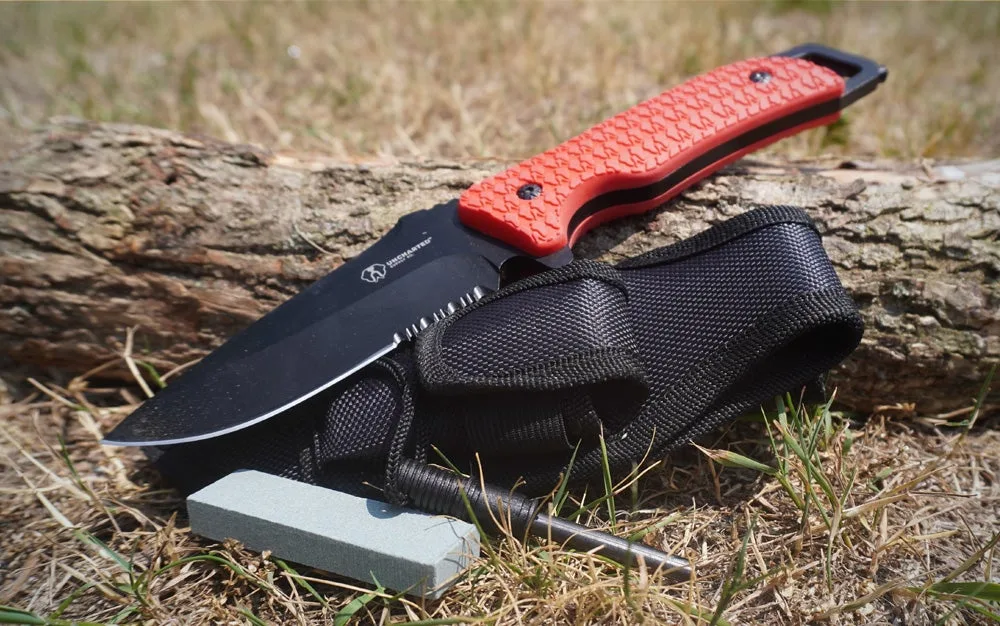
A close-up of the Uncharted Supply Co. Empire during testing. (Photo/Travis Smola) Travis Smola
For a $40 knife, it has a surprisingly thick blade that easily handled a batoning test while keeping its edge. I found the small, serrated edge also does a handy job sawing through small limbs. Backpackers obviously won’t need the emergency glass breaker on this knife, but it does come with a handy bonus bottle opener, perfect for once you get back to civilization to celebrate with friends.
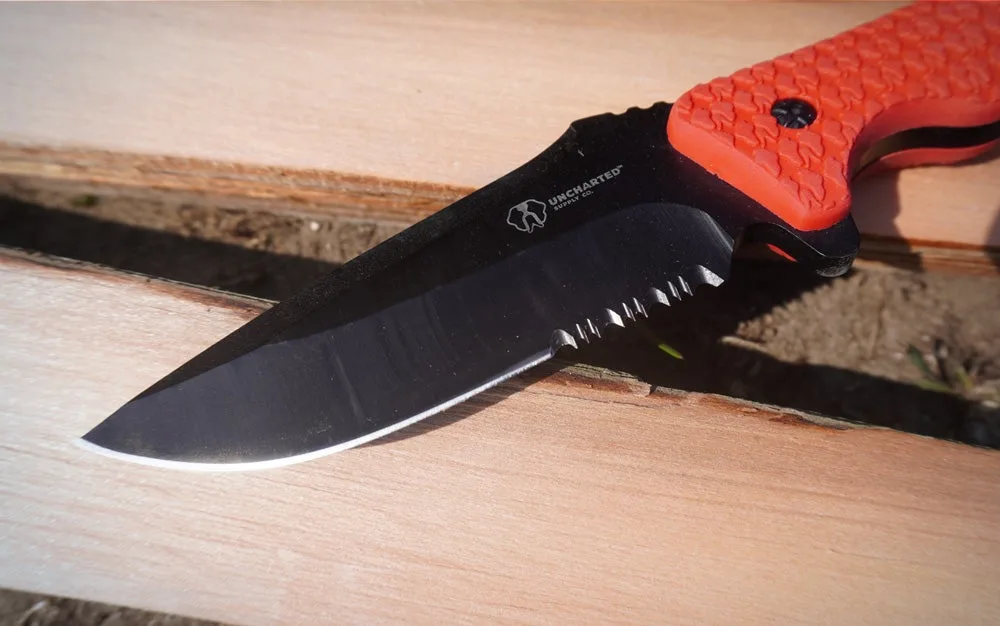
The Empire knife kept its edge and finish even after being used to cleanly baton a piece of wood. (Photo/Travis Smola)
The sheath for this knife is decent, but the real added value comes with the included sharpening stone and ferro rod. After excessive use and testing, I still didn’t need to sharpen it. Uncharted put an excellent edge on this knife straight from the factory. It’s even more impressive given my blade came from a pre-packed bug out bag. Given the quality of the blade and the handle, it makes me wonder how Uncharted can afford to sell this knife for only $40.
Best Ultralight: CRKT Minimalist Drop Point
Specs
Blade Material: 154CM or 5CR15MOV
Blade Length: 2.16”
Overall Length: 5.25”
Tang: Full
Pros
Multiple steel options for different budgets
Weighs practically nothing
Versatile for a variety of camp tasks
Cons
Handle is tiny
For backpackers who are obsessed with limiting weight in their pack, the Columbia River Knife & Tool Minimalist is the answer. Coming in at just 1.8 ounces, this tiny, full tang knife packs a lot of functionality into a small package. The first thing I noticed was that I couldn’t get my pinky on the handle because of the small size—measuring just over 5 inches long.
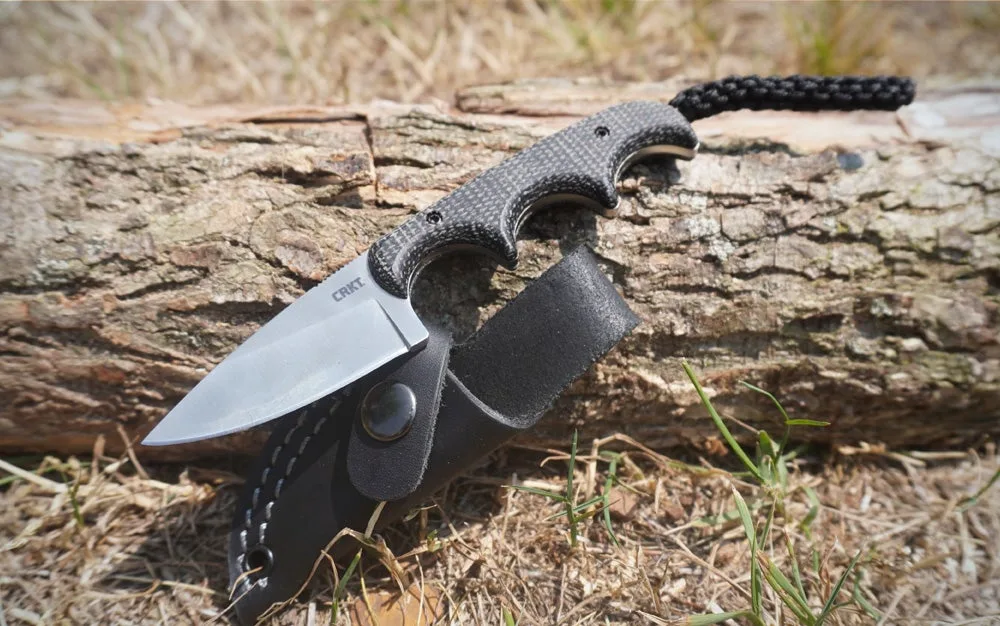
A close-up of the CRKT Minimalist during testing. (Photo/Travis Smola) Travis Smola
I found the small size doesn’t really affect the functionality too much, although the control on finer wood carving or food prep tasks may be more challenging for those with larger hands. I also found it will also spark a ferro rod nicely in a pinch.

The Minimalist is a truly tiny fixed blade knife. (Photo/Travis Smola)
The nice thing about this small knife is that CRKT offers it in two different types of steel and handles. The higher quality 154CM steel with a Micarta handle ended up handling every task I gave it, big or small, despite the tiny blade size. However, I also love the fact CRKT offers a 5CR15MOV steel with a G10 handle variant that costs less than $40.
Best Chef Knife: CRKT S.P.E.C. Fixed Blade
Specs
Blade Material: 8Cr13MoV
Blade Length: 2.44”
Overall Length: 5.63”
Tang: Full
Pros
Great handle
Affordable price point
Versatile enough for light bushcraft
Cons
Low-grade steel
Needs sharpening often
Gourmet meals aren’t usually on the menu in the backcountry. But I also know there are plenty of hikers who find ways to bring fresh fruit and other food with them. And the tiny CRKT S.P.E.C. Cleaver is a good choice for those who need to chop food.
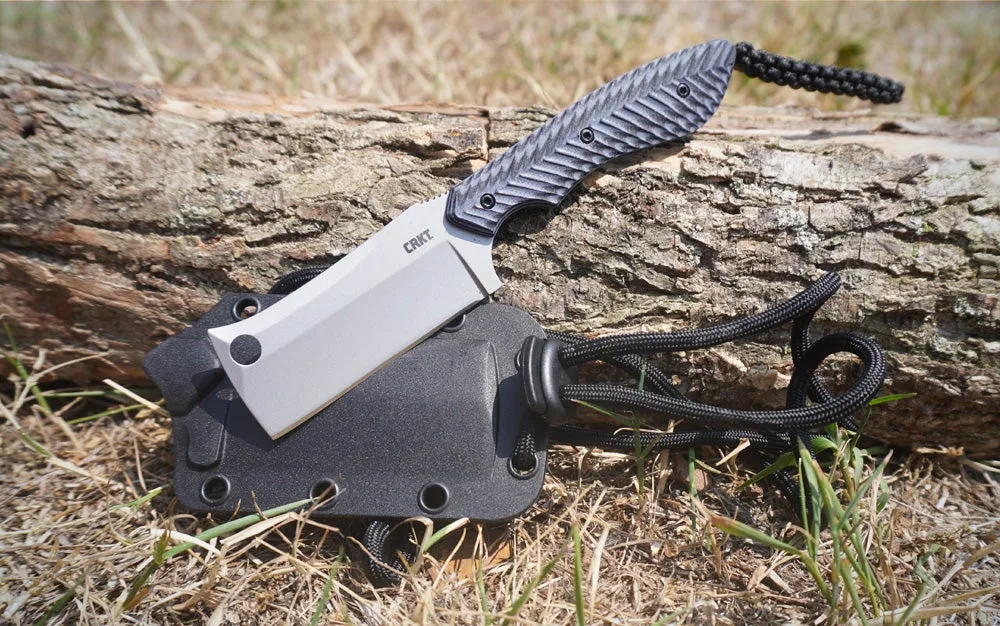
A close-up of the CRKT S.P.E.C. during testing. (Photo/Travis Smola) Travis Smola
The compact blade is made from low-grade 8Cr13MoV steel, but my test sample was given an excellent edge from the factory that made food prep easy. I also subjected this blade to the rugged cardboard test, where it passed with fly colors. This cleaver is also ideal for other small camp tasks.
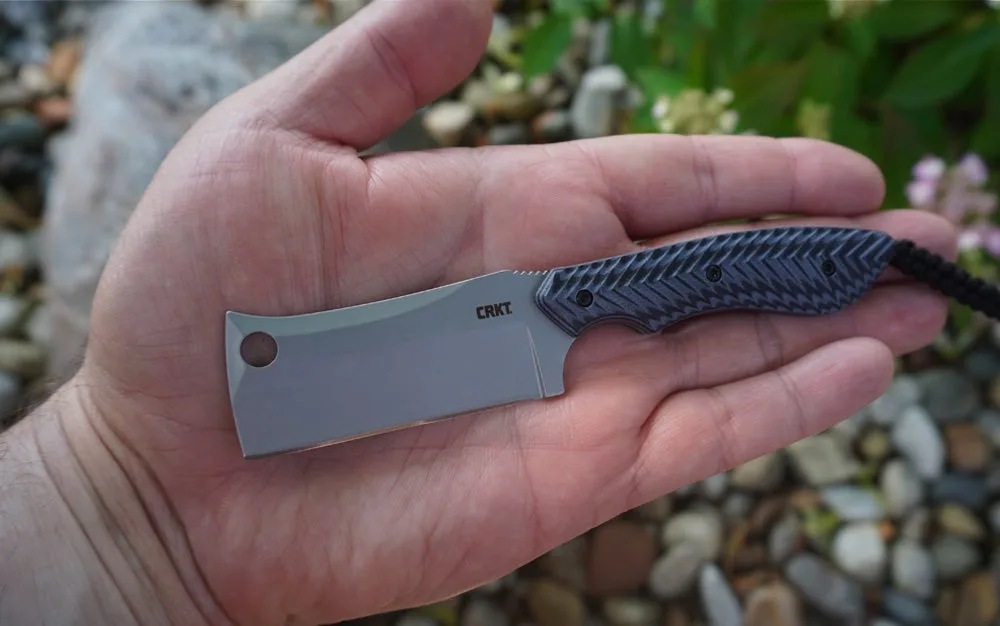
The CRKT S.P.E.C. Cleaver is an extremely small and lightweight—perfect for camp tasks. (Photo/Travis Smola)
Just like the Minimalist drop point, this is a surprisingly tiny fixed blade knife (see photo above). However, I like the G10 handle on this knife a little better than the one on the Minimalist. It has a great texture that I found easy to grip, even with wet hands.
How We Tested Backpacking Knives
Any knife that is lightweight with an ergonomic design is ideal for taking into the backcountry. And it doesn’t matter if the pursuit is hunting, fishing, or camping—the blade has to be lightweight, durable, and extremely sharp. So to help us find the best of the best, we called in an array of quality knives made. Then we put each knife through its paces—wood carving, spark testing, splitting wood, and other camp maintenance chores—to see how they performed in real-world situations.
After that, we kicked it up a notch. To determine the edge retention for each blade, we subjected the knives to some extra abuse beyond their normal uses. Most notably, we used them to cut highly abrasive cardboard to test edge retention. That may seem odd, but cardboard dulls blades quicker than most materials due to its construction. Thus, it was easy to see which blades held an edge longer than others.
Since different backpacking pursuits call for different needs, we also considered the following factors when deciding where to rank each blade:
Blade Material: What type of steel is the blade made from?
Tang: If this is a fixed blade, does it have a full tang for extra strength and leverage?
Edge Retention: How well did the edge hold up to our most abusive tests? Is the blade easy to sharpen?
Ergonomics: How comfortable is the handle? Does the knife feel balanced?
Value: Does the price of the knife match its construction and performance?
How to Choose a Backpacking Knife
The old saying: “You get what you pay for,” mostly rings true when it comes to knives. However, there is something to be said for not breaking the bank. Plus, you don’t have to worry if you scratch, break, or lose a $40 knife like you would if you lost a high-grade, $300 knife. As much as I love my Benchmade knives, it does make me a bit paranoid when I take them into the woods. That said, every backpacker’s needs are going to be different, so it’s important to consider these factors before deciding on a knife.
Steel Quality
There are various types of steel that knives are made from. And the quality of a particular type of steel will directly affect the price of a knife. Most cheap knives utilize 8Cr13MoV steel. This is a high-carbon steel that offers excellent corrosion resistance and is easy to sharpen. However, it isn’t durable and will likely require a lot of maintenance.
On the flip side, higher-grade steel like S30V usually offers much better durability, edge retention, and corrosion resistance than budget knives. The downside, other than cost, is that steel like S30V is usually more difficult to sharpen. For beginners, these harder steel blades can be downright frustrating to put an edge back on them.
Blade and Handle Types
It’s also worth considering the type of blade you need. A simple drop point will be more than functional for most hikers. Drop points feature a deeper blade that is versatile for a variety of cutting scenarios you might encounter in the backcountry. This blade type is also usually thicker, which makes them robust enough for bushcrafting activities, especially whittling, carving, and fire-starting.
A simple razor edge will be fine for most backpackers. However, many survival knives now feature a serrated edge which makes it easier to saw through small branches and wood. They work fine for backpacking, but just be aware the serrations are much harder to maintain in the long run.
For fixed blade knives, I recommend a full tang—meaning the construction of the blade extends all the way through the handle. This lends more strength to the blade, especially if you plan to baton wood or do other major woodworking activities. I personally like a handle that’s wider because it just offers a great deal of control while making precise cuts.
FAQs
Q: What type of knife is best for backpacking?
This is a matter of personal preference. Some hikers are going to be more focused on food prep, while others need a knife for woodworking or bushcraft projects. Fixed blade knives are a good choice for bushcraft enthusiasts who plan to build shelters, start fires, or split wood. Backpackers who just need a knife for cutting paracord, light meal prep, or gear repairs can usually make do with a small folding knife.
Q: What is the best size knife for backpacking?
Because every backpacker will have different needs depending on their style, it’s hard to pinpoint a specific “best” size. We like two- to four-inch blades backpacking adventures. If you plan to baton wood, do bushcraft, or light a fire, a slightly longer blade is usually better. At the same time, backpackers need to be careful about going too large because longer blades are harder to maintain and will add additional weight to their pack.
Q: How do I store a backpacking knife?
Smaller backpacking knives are easy to store inside a pocket on their pack. However, backpackers should check the knife concealment laws of the state they are hiking in. Every state has different regulations on what they consider a concealed knife. For most fixed blade knives, especially those over five inches, your best bet is to carry them in a sheath on the outside of your pack or a belt loop.
Why Trust Us
For more than 125 years, Field & Stream has been providing readers with honest and authentic coverage of outdoor gear. Our writers and editors eat, sleep, and breathe the outdoors, and that passion comes through in our product reviews. You can count on F&S to keep you up to date on the best new gear. And when we write about a product—whether it’s a bass lure or a backpack—we cover the good and the bad, so you know exactly what to expect before you decide to make a purchase.

